Kasi Viswanathar Temple Kumbakonam: Temple of 1000 Divine Lights
Kasi Viswanathar Temple, Kumbakonam is a Hindu temple dedicated to Lord Shiva, located in Kumbakonam, Tamil Nadu, India. Here, Lord Shiva is worshipped as Kasi Viswanathar, and His consort Parvati is depicted as Visalakshi. The presiding deity is revered in the 7th-century Tamil Saiva canonical work, the Tevaram, written by Tamil saint poets known as the nayanars and classified as Paadal Petra Sthalam.
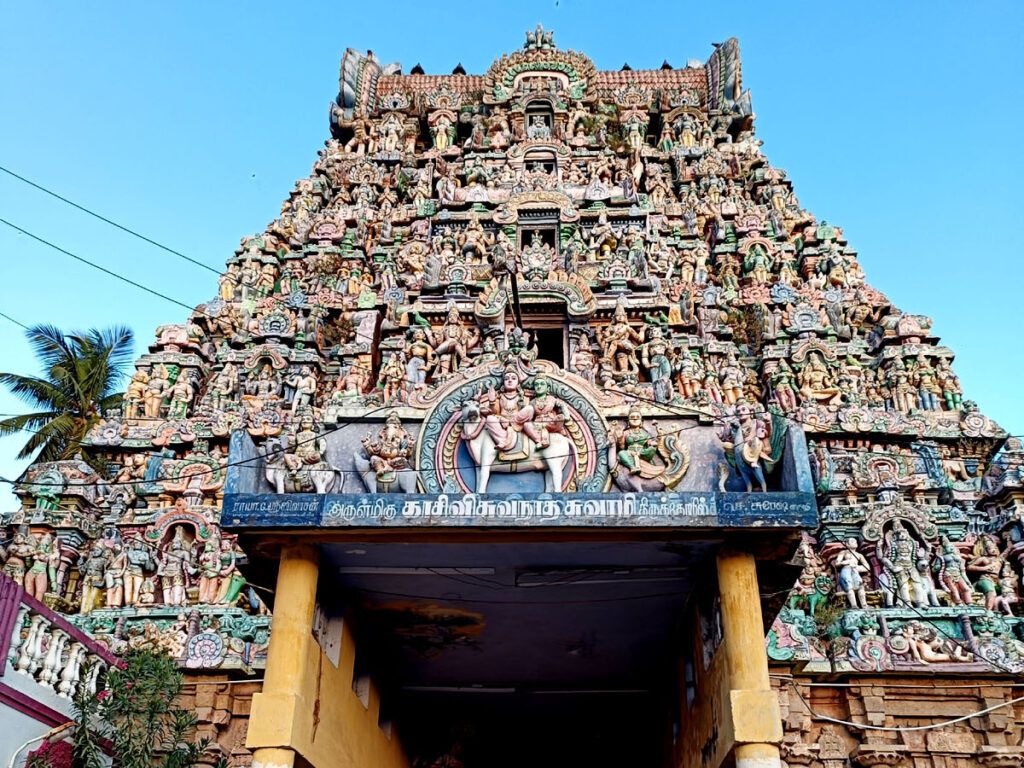
Sanskrit Sloka:
द्राविड शिल्प कला का अनुपम निदर्श
कूंभकोणम में विराजमान कशी विश्वनाथ
गंगा यमुना काशी के संगम के समान
पापों का नाश करने वाला अद्भुत धाम
English Meaning:
An unparalleled example of Dravidian architecture
Kashi Vishwanath, who resides in Kumbakonam
Like the confluence of Ganga Yamuna Kashi
An amazing abode that destroys sins
Contents
- 1 History of Kasi Viswanathar Temple Kumbakonam:
- 2 Legend of Kasi Viswanathar Temple Kumbakonam:
- 3 Significance of Kasi Viswanathar Temple Kumbakonam:
- 4 Myths of Kasi Viswanathar Temple Kumbakonam:
- 5 Architecture of Kasi Viswanathar Temple Kumbakonam:
- 6 Speciality of Kasi Viswanathar Temple Kumbakonam:
- 7 Kasi Viswanathar Temple Timing:
- 8 Places to visit near Kasi Viswanathar Temple Kumbakonam:
- 9 FAQ:
- 9.0.1 Q: When was the Kasi Viswanathar Temple built?
- 9.0.2 Q: What are the main features of the Kasi Viswanathar Temple?
- 9.0.3 Q: What are the religious significance of the Kasi Viswanathar Temple?
- 9.0.4 Q: What are the festivals celebrated at the Kasi Viswanathar Temple?
- 9.0.5 Q: What is the Kasi Viswanathar Temple?
- 10 How to reach Kasi Viswanathar Temple Kumbakonam:
- 11 Google Maps:
History of Kasi Viswanathar Temple Kumbakonam:
The Kasi Viswanathar Temple in Kumbakonam, Tamil Nadu, India, is a Hindu temple dedicated to Lord Shiva. It is one of the 108 Divya Desams, or holy places of worship, of the Tamil Saiva Nayanars. The temple is said to have been built by the Chola king, Kulothunga Chola I, in the 11th century.
The temple is located on the north bank of the Mahamakam tank, which is one of the five holy tanks in Kumbakonam. The temple complex covers an area of approximately two acres and is surrounded by a high wall. The main entrance to the temple is through the Rajagopuram, or royal gateway, which is seven stories tall and has a height of 72 feet.
The presiding deity of the temple is Lord Shiva, who is worshipped as Kasi Viswanathar. The Shiva Lingam in the temple is said to have been installed by Sage Agastya. The goddess Parvati is worshipped as Visalakshi.
The temple is home to a number of other deities, including Ganesha, Murugan, Nataraja, and Vishnu. The temple also has a number of shrines dedicated to the Nayanars.
The temple is an important pilgrimage destination for Hindus from all over the world. The temple is also a popular tourist destination.
The temple is associated with a number of legends. One legend states that Lord Rama and Lakshmana worshipped Lord Shiva at this temple during their search for Sita. Another legend states that the nine sacred rivers of India prayed to Lord Shiva at Varanasi (Viswanathar) to be absolved of the sins washed away by bathers, and were directed to bathe in the Mahamakam tank and worship Adi Kumbeswarar Temple.
Read More>> Shri Kalabhairaveshwara Temple Bengaluru
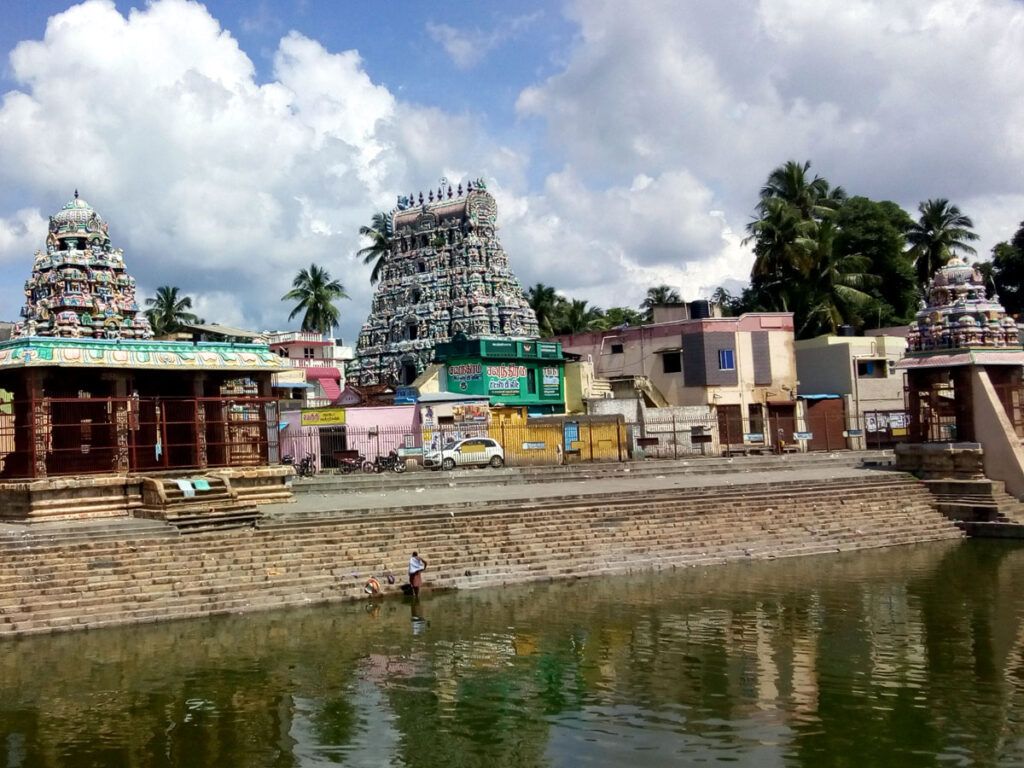
Legend of Kasi Viswanathar Temple Kumbakonam:
The legend of the Kasi Viswanathar Temple begins with the story of King Visweswarar. Visweswarar was a pious king who ruled over the city of Kumbakonam. He was a devout follower of Lord Shiva, and he prayed to the god to grant him a son.
One day, Lord Shiva appeared to Visweswarar in a dream and told him that his prayers had been answered. He said that Visweswarar would be blessed with a son, and that the boy would be a great devotee of Shiva.
Soon after, Visweswarar’s wife gave birth to a son. The boy was named Viswanathar, and he grew up to be a kind and compassionate ruler. He was also a great devotee of Shiva, and he often visited the Kashi Vishwanath Temple in Varanasi.
One day, Viswanathar was visiting the Kashi Vishwanath Temple when he had a vision. In the vision, Shiva told Viswanathar that he wanted a replica of the Kashi Vishwanath Temple to be built in Kumbakonam.
Viswanathar was overjoyed by Shiva’s vision. He immediately returned to Kumbakonam and began construction on the temple. The temple was built using the finest materials, and it took many years to complete.
When the temple was finally completed, it was a magnificent sight. It was a replica of the Kashi Vishwanath Temple, and it was a testament to Viswanathar’s devotion to Shiva.
The Kasi Viswanathar Temple is still an important pilgrimage site today. It is a popular destination for Hindus from all over the world.
Read More>> Arunachaleswara Temple: A Spiritual Experience of a Lifetime
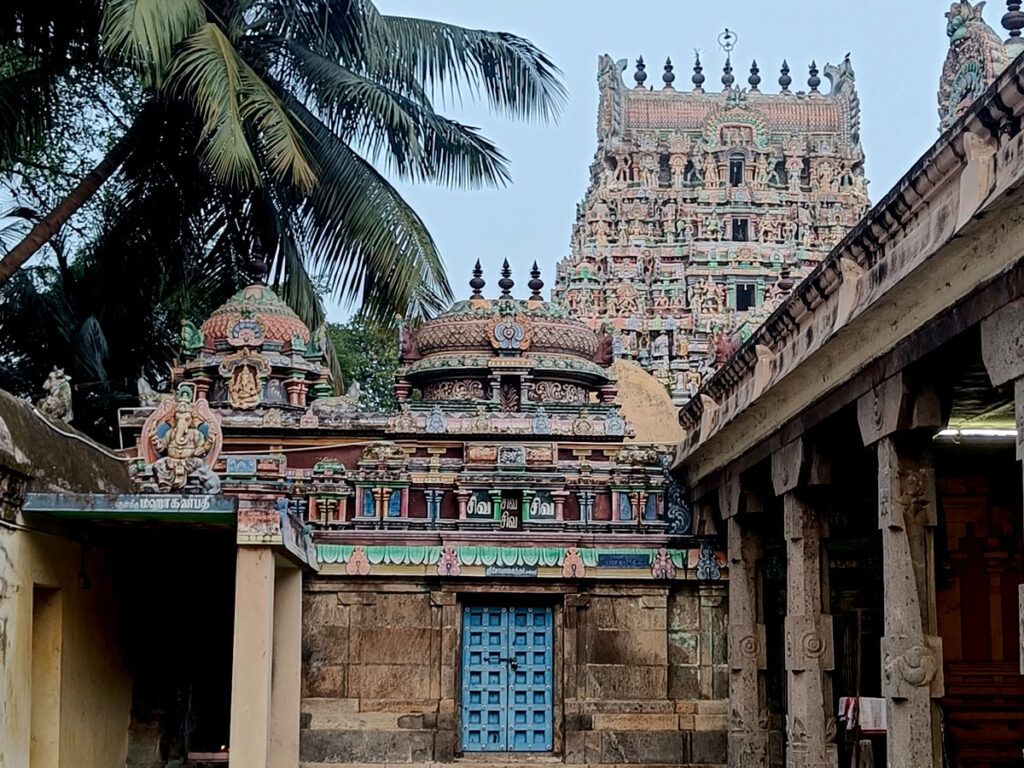
Significance of Kasi Viswanathar Temple Kumbakonam:
Historical Significance
The Kasi Viswanathar Temple traces its origins to the Chola period, dating back to the 7th century CE. It is believed that the temple was constructed by the Pallava king Kopperunchinga Chola II, who was a fervent devotee of Lord Shiva. Over the centuries, the temple has undergone several renovations and expansions, each adding to its architectural splendor and spiritual significance.
Architectural Grandeur
The Kasi Viswanathar Temple stands as a testament to the architectural prowess of the Chola era. Its towering gopuram, adorned with intricate sculptures and vibrant colors, serves as a beacon of faith and a symbol of the temple’s grand stature. The temple complex encompasses a vast courtyard, adorned with numerous shrines dedicated to various deities. The sanctum sanctorum, where the revered Kasi Viswanathar lingam resides, exudes an aura of tranquility and spiritual devotion.
Spiritual Significance
The Kasi Viswanathar Temple is revered as one of the Pancha Sabhai Kshetras, five sacred Shiva temples believed to represent the five elements of nature. Devotees believe that worshipping at this temple grants liberation from the cycle of birth and death. The temple is also associated with the legend of Lord Shiva’s victory over the demon Ravana, further enhancing its spiritual significance.
Festivals and Celebrations
The Kasi Viswanathar Temple is a hub of religious fervor throughout the year. Numerous festivals and celebrations take place within its hallowed precincts, drawing devotees from far and wide. These events showcase the temple’s rich cultural heritage and provide opportunities for spiritual enlightenment.
Symbol of Cultural Heritage
The Kasi Viswanathar Temple stands as a symbol of India’s rich cultural heritage, embodying the architectural, artistic, and spiritual traditions that have shaped the country’s identity. It serves as a beacon of faith and inspiration for countless devotees, reminding them of the enduring power of spirituality.
Read More>> Divine Mata Vaishno Devi Temple | Shaktipeeth Complete Guide
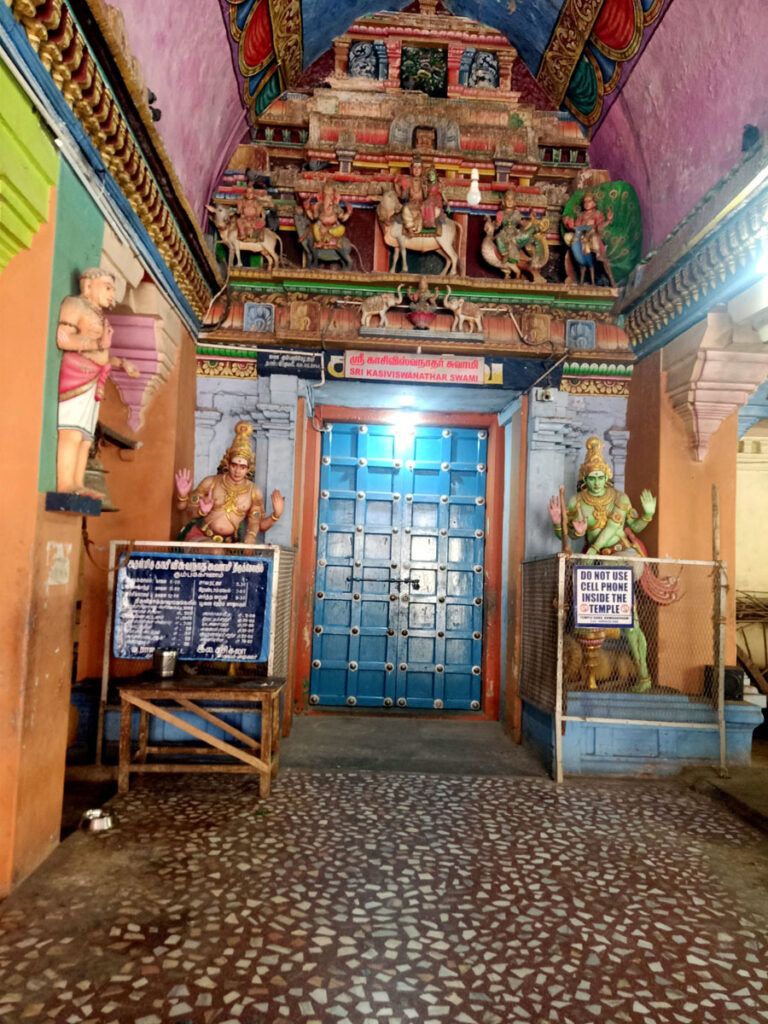
Myths of Kasi Viswanathar Temple Kumbakonam:
According to the myth, the Pandavas were on their way to heaven after the Mahabharata war. They stopped at Kumbakonam to perform a penance to Shiva. As they were praying, Shiva appeared to them and told them that he would grant them a boon.
The Pandavas asked Shiva to build a temple for him in Kumbakonam. Shiva agreed, and he instructed the Pandavas to dig a pit in the ground. When they did, they found a Shiva lingam buried in the earth.
The Pandavas built a temple around the lingam, and it became known as the Kasi Viswanathar Temple. The temple is still standing today, and it is one of the most popular pilgrimage sites in India.
Another myth about the temple is about the origin of the name “Kasi.” According to the myth, Shiva once came to Kumbakonam to visit the Pandavas. He was so impressed with the town that he said that it would be known as “Kasi,” which means “holy city.”
The temple is also home to a number of other myths and legends, including one about a demon named Somadatta. Somadatta was a powerful demon who was terrorizing the people of Kumbakonam. The Pandavas were able to defeat Somadatta, and they built a shrine to Shiva on the spot where he was killed.
The Kasi Viswanathar Temple is a rich and complex temple with a long and fascinating history. The many myths and legends that surround the temple add to its mystique and make it a truly special place.
Here are some of the other myths and legends associated with the Kasi Viswanathar Temple:
- One myth says that the temple was built by the sage Agastya.
- Another myth says that the temple was built by the Chola king, Kulothunga Chola I.
- A third myth says that the temple was built by the Pandya king, Sundara Pandya.
Read More>> Subramanya Swamy Temple at Tiruttani

Architecture of Kasi Viswanathar Temple Kumbakonam:
The Kasi Viswanathar Temple in Kumbakonam, Tamil Nadu, India, is a Dravidian-style Hindu temple dedicated to the god Shiva. It is one of the most important temples in the region and is known for its intricate architecture and beautiful sculptures.
The temple was built in the 12th century by the Chola dynasty. It is a large complex with a number of different shrines, including the main shrine dedicated to Kasi Viswanathar. The main shrine is a square structure with a pyramidal roof. It is decorated with intricate carvings of gods, goddesses, and other mythological figures.
The temple also has a number of other shrines dedicated to other Hindu deities, including Vishnu, Parvati, and Ganesha. There are also a number of smaller shrines dedicated to local deities.
The temple is surrounded by a large wall that is decorated with sculptures. The wall has a number of gopurams, or towers, that are decorated with intricate carvings.
The temple is a popular pilgrimage destination for Hindus from all over the world. It is also a popular tourist destination.
Here are some of the architectural features of the Kasi Viswanathar Temple:
- The main shrine is a square structure with a pyramidal roof. The roof is made of granite and is decorated with intricate carvings of gods, goddesses, and other mythological figures.
- The walls of the temple are decorated with sculptures. The sculptures depict gods, goddesses, mythological figures, and scenes from Hindu mythology.
- The temple has a number of gopurams, or towers. The gopurams are decorated with intricate carvings and are a distinctive feature of Dravidian-style temples.
Read More>> Tripura Sundari Temple in Tripura
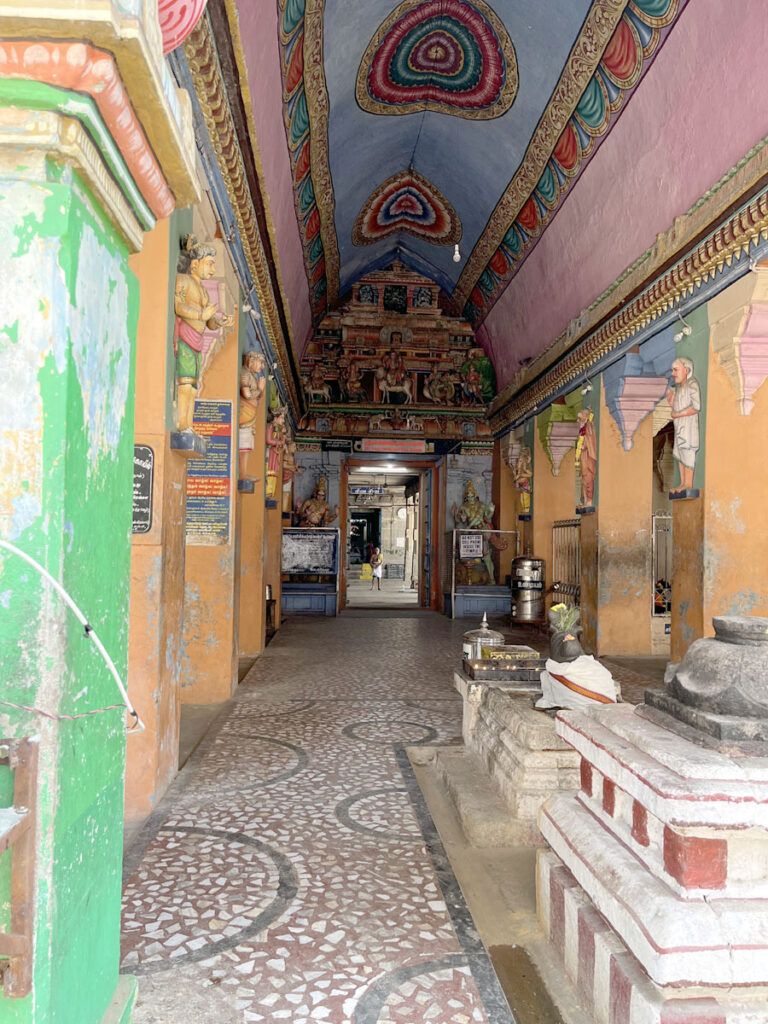
Speciality of Kasi Viswanathar Temple Kumbakonam:
The lingam: The lingam in the temple is said to be self-manifested, or swayambhu. It is made of black granite and is about 5 feet tall. The lingam is believed to have the power to grant wishes.
The architecture: The temple is built in the Dravidian style of architecture. The main temple complex is surrounded by a moat and has a series of towers and gateways. The temple is decorated with sculptures and carvings of Hindu deities and scenes from Hindu mythology.
The festivals: The temple hosts a number of festivals throughout the year. The most important festival is the Mahamaheshwaram festival, which is held in the month of March or April. During this festival, the lingam is bathed in milk and other holy fluids.
Kasi Viswanathar Temple Timing:
- The morning darshan begins at 5:00 AM and ends at 12:00 PM.
- The evening darshan begins at 4:00 PM and ends at 9:00 PM.
- The temple is closed for an hour at noon for lunch.
- On special occasions, such as festivals, the temple may be open for longer hours.
Read More>> Kedarnath Temple: Where Faith Meets Jyotirling & Char Dham Yatra
Places to visit near Kasi Viswanathar Temple Kumbakonam:
Sarangapani Temple: This is another important temple in Kumbakonam dedicated to Lord Vishnu. It is one of the Divya Desams and is known for its magnificent architecture.
Mahamaham Tank: A sacred tank in Kumbakonam, Mahamaham Tank is believed to be connected to the sacred rivers of India. Pilgrims take a dip in the tank during the Mahamaham festival, which occurs once in 12 years.
Adi Kumbeswarar Temple: This is one of the oldest Shiva temples in Kumbakonam and is dedicated to Lord Kumbeswarar. The temple has a unique architectural style.
Nageswaran Temple: This temple is dedicated to Lord Shiva and is known for its intricate architecture and sculptures. It is also called “Koothandavar Kovil.”
Airavatesvara Temple: Located in Darasuram, a nearby town, this UNESCO World Heritage Site is dedicated to Lord Shiva. The temple is known for its remarkable Chola architecture.
Swamimalai Murugan Temple: This temple, dedicated to Lord Murugan, is situated in Swamimalai, about 8 km from Kumbakonam. It is one of the Arupadaiveedu, the six holy abodes of Lord Murugan.
Thiruvidaimarudur Mahalinga Swamy Temple: Located about 8 km from Kumbakonam, this temple is dedicated to Lord Mahalinga (Lord Shiva) and is associated with the Maha Maham festival.
Darasuram: Apart from the Airavatesvara Temple, Darasuram is known for its silk weaving industry. You can explore the town and witness the traditional silk weaving process.
Gangaikonda Cholapuram: This historical site, around 70 km from Kumbakonam, has the Gangaikonda Cholapuram Temple built by Rajendra Chola I. It is another UNESCO World Heritage Site.
Thirumanancheri Temple: This temple is dedicated to Lord Shiva and is known for its association with marriages. It is believed that praying here can lead to marital bliss.
FAQ:
Q: When was the Kasi Viswanathar Temple built?
A: The Kasi Viswanathar Temple was built in the 12th century by the Chola king Kulothunga Chola I. The temple was originally built in the Dravidian style of architecture, but it has undergone several renovations over the centuries. The most recent renovation was completed in the 19th century.
Q: What are the main features of the Kasi Viswanathar Temple?
A: The Kasi Viswanathar Temple is a large temple complex that covers an area of over 30 acres. The main temple is dedicated to Vishnu, who is worshipped in the form of Kasi Viswanathar. The temple also has shrines dedicated to other Hindu deities, including Lakshmi, Shiva, and Hanuman.
The main temple is a five-tiered structure that is made of granite. The temple has a tall gopuram, or tower, that is over 150 feet tall. The gopuram is decorated with intricate carvings of Hindu deities and scenes from Hindu mythology.
The temple also has a number of other shrines, including a shrine dedicated to the goddess Lakshmi, who is Vishnu’s consort. The Lakshmi shrine is located in the inner sanctum of the temple and is only accessible to priests.
Q: What are the religious significance of the Kasi Viswanathar Temple?
A: The Kasi Viswanathar Temple is one of the most important Vishnu temples in India. The temple is believed to be a replica of the Kasi Viswanathar Temple in Varanasi, which is one of the most sacred pilgrimage sites in Hinduism.
The temple is also believed to be a place where Vishnu appeared to the sage Agastya. Agastya is a revered figure in Hinduism and is said to have brought the Vedas to India.
The temple is a popular pilgrimage destination for Hindus from all over the world.
Q: What are the festivals celebrated at the Kasi Viswanathar Temple?
A: The Kasi Viswanathar Temple celebrates a number of festivals throughout the year. The most important festival is the Brahmotsavam, which is celebrated in the month of May. The Brahmotsavam is a 10-day festival that includes a number of religious ceremonies and processions.
Other festivals celebrated at the temple include the Vaikunda Ekadasi, the Krishna Janmashtami, and the Karthigai Deepam.
The Kasi Viswanathar Temple is a beautiful and sacred place that is worth visiting if you are interested in Hinduism or Indian architecture.
Q: What is the Kasi Viswanathar Temple?
The Kasi Viswanathar Temple is a Hindu temple dedicated to the god Vishnu located in the town of Kumbakonam in the Indian state of Tamil Nadu. It is one of the 108 Divya Desams, or holy places of Vishnu worship, and is considered to be one of the most important Vishnu temples in South India.
How to reach Kasi Viswanathar Temple Kumbakonam:
By Air:
The nearest airport is Tiruchirapalli International Airport (TRZ), which is approximately 91 kilometers away from Kumbakonam. From the airport, you can hire a taxi or use other modes of transportation to reach Kumbakonam.
By Train:
Kumbakonam has its own railway station, Kumbakonam Junction (station code: KMU), which is well-connected to major cities in Tamil Nadu and other parts of India. You can take a train to Kumbakonam and then use local transportation to reach the Kasi Viswanathar Temple.
By Bus:
Kumbakonam has a well-established bus network, and you can reach the town by state-run or private buses from various cities in Tamil Nadu. Once you reach the Kumbakonam bus stand, you can hire a taxi, auto-rickshaw, or use other local transportation to get to the temple.
By Road:
If you’re traveling by car, Kumbakonam is well-connected by roads. You can use a GPS device or map to navigate your way to Kumbakonam. Once you reach the town, you can follow local directions to the Kasi Viswanathar Temple.
Local Transportation:
Once you are in Kumbakonam, you can use local transportation options like auto-rickshaws or taxis to reach the Kasi Viswanathar Temple. Many temples in India are centrally located and easily accessible from major landmarks in the town.
